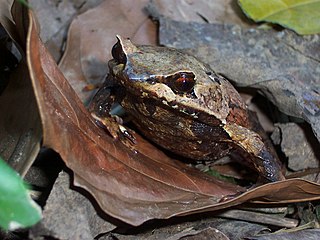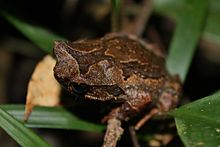
Megophryidae, commonly known as goose frogs, is a large family of frogs native to the warm southeast of Asia, from the Himalayan foothills eastwards, south to Indonesia and the Greater Sunda Islands in Maritime Southeast Asia, and extending to the Philippines. Fossil remains are also known from North America. As of 2014 it encompasses 246 species of frogs divided between five genera. For lack of a better vernacular name, they are commonly called megophryids.

The long-nosed horned frog, also known as the Malayan horned frog or Malayan leaf frog is a species of frog restricted to the rainforest areas of southern Thailand and Peninsular Malaysia to Singapore, Sumatra, and Borneo. However, records from Thailand to the Sunda Shelf may apply to another, possibly unnamed species.

Megophrys is a genus of frogs in the family Megophryidae. They are endemic to Indonesia, where they are found on the islands of Java and Sumatra. They commonly have elongated upper "eyebrows" and are thus known as Indonesian horned toads. This group was thought to contain many more species and have a much wider distribution prior to recent taxonomic revisions.

Xenophrys glandulosa, the glandular horned toad or Jingdong spadefoot toad is a species of amphibian in the family Megophryidae found in Yunnan in China, in Nagaland in northeastern India, and in northern Kachin State, Myanmar. It has recently been reported from Bhutan. Its type locality is Mount Wuliang in Jingdong County, Yunnan. Its natural habitats are tropical moist montane forests and rivers.
Pelobatrachus edwardinae is a species of frog in the family Megophryidae. It is commonly known as the rough horned frog, Edwardina's horned frog, and Edwardina's spadefoot toad. It is endemic to northern Borneo and known from the Sabah and Sarawak provinces of Malaysia as well as from Brunei. Its natural habitats are tropical moist lowland forests and rivers. It is threatened by habitat loss

The Palawan horned frog is a species of frog in the family Megophryidae. It is endemic to the Balabac and Palawan islands, in the Philippines. Its natural habitats are subtropical or tropical dry forests, subtropical or tropical moist lowland forests, subtropical or tropical moist montane forests, subtropical or tropical moist shrubland, rivers, and intermittent rivers. It is threatened by habitat loss.

The Mindanao horned frog is a species of amphibian in the family Megophryidae. It is endemic to the Philippines.

Xenophrys aceras, commonly known as the Perak horned toad, Perak spadefoot toad or Malayan horned frog, is a species of frog in the family Megophryidae found in Peninsular Malaysia and Thailand, and possibly in Indonesia. Its common name refers to its type locality, Bukit Besar in Perak state, Malaysia.

Xenophrys is a genus of amphibians in the family Megophryidae. They are found in southeastern Asia to Borneo. Their common name is strange-horned toads.
Xenophrys auralensis is a species of frog in the family Megophryidae. It is endemic to Cambodia where it is only known from Phnom Aural, the highest mountain of Cambodia. Its type locality is within the Phnom Aural Wildlife Sanctuary. Its natural habitats are tropical moist lowland forests, moist montane forests, and rivers.

Xenophrys longipes is a species of frog in the family Megophryidae. It is also known as the Malacca spadefoot toad, red legged spine-eyed frog, red-legged horn frog, and slender-legged horned frog. It is found in the Malay Peninsula. Records from Cambodia and Vietnam are considered doubtful.
The Mangshan horned toad, or Mangshan spadefoot toad, is a species of frog in the family Megophryidae. It is endemic to China and known only from southern Hunan and northern Guangdong; its type locality is Mount Mang (Mangshan) in Yizhang County, Hunan. Its natural habitats are subtropical or tropical moist lowland forests, subtropical or tropical moist montane forests, and rivers. It is threatened by habitat loss.
The Medog horned toad, or Medog spadefoot toad, is a species of frog in the family Megophryidae. It was described as a subspecies of Omei horned toad based on specimens collected from Mêdog County, Tibet (China); it is still only known from its type locality. It probably has a wider distribution that may reach India. Its natural habitats are subtropical or tropical moist lowland forests, subtropical or tropical moist montane forests, and rivers.
The convex-vented horned toad, also known as the Gelin spadefoot toad or Huang's spadefoot toad, is a species of frog in the family Megophryidae. It is found in Tibet (China) and northern Vietnam, and possibly in India. Its natural habitats are subtropical or tropical moist montane forests and rivers.
Boulenophrys shuichengensis is a species of amphibian in the family Megophryidae. It is endemic to China: it is only known from the type locality, Fenghuang Village in Shuicheng County, Guizhou. Its natural habitats are subtropical or tropical moist montane forests and rivers.
Zhang's horned toad, or Zhang's spadefoot toad, is a species of frog in the family Megophryidae. It is found in Zhangmu, Nyalam County, Tibet, China . Its natural habitats are temperate forests and rivers.
Xenophrys lekaguli is a species of frog in the family Megophryidae. It is endemic to Southeast Asia and is known from the Chanthaburi and Sa Kaeo Provinces in eastern Thailand and from the Cardamom Mountains in Pursat Province, western Cambodia. The specific name commemorates Thai zoologist and conservationist Dr Boonsong Lekagul.
Xenophrys damrei is a species of megophryid toad endemic to Cambodia. It is only known from its type locality, Bokor Plateau in the Dâmrei Mountains of southern Cambodia. The species description was published in 2011 but was based on samples collected by Malcolm Arthur Smith in 1914. The species has not been observed in surveys ever since, although this might reflect seasonal variability. The known specimens measure 69 mm (2.7 in) and 57 mm (2.2 in) in snout–vent length.

Pelobatrachus is a genus of frogs in the family Megophryidae. It was formerly synonymized with Megophrys until 2021, when it was revived as a distinct genus. They inhabit Southeast Asia, namely the Malay Peninsula, Sumatra, Borneo and the Philippines. Their common name is clay horned toads.









